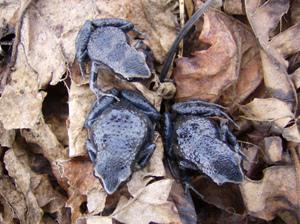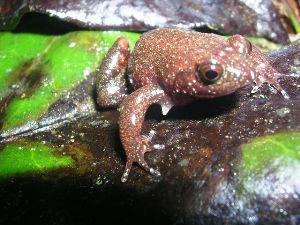Gonwouo Nono Legrand
This study investigates how anthropogenic activities influence the composition, distribution and status of endemic amphibians on mount Manengouba. This should set the base for monitoring program for amphibians and contribute to a sustainable land management strategy in the region.

Cardioglossa trifasciata.
Mount Manengouba harbours over 50% of the anuran fauna endemic to the Cameroon Highlands (Amiet 1975; Gartshore 1986,) ranking among the highest in Africa for both species diversity and endemism (Wild 2004). Strict endemics to this region include: Cardioglossa trifasciata and Leptodactylodon erythrogaster only known from the submontane forest of Manenguoba (Amiet, 1975), and the recently discovered Cardioglossa sp. nov recorded during the first phase of this study above 2000m. These mountain uplands are one of the most important centres of endemism on the African continent and are considered a priority area for conservation globally (Myers et al. 2000, Cheek et al. 2004).

Leptodactylodon erythrogaster.
Despite its high degree of diversity and endemism, its future is uncertain. Increasing agricultural development, forest clearance, Prunus africanus exploitation, burning and grazing for livestock is reducing the forest cover. Increasing forest fragmentation can be the result leading to lower temperatures and reduced humidity with obvious advert effects on endemic amphibian species. This study investigates how human activities influence the distribution of the endangered endemic amphibians using GIS tool to document where they occur for site conservation measures.
To achieve this goal, the study area has been divided into three main blocks following an altitudinal gradient. Lowland < 800 m; Submontane 800 – 1600 m; Montane > 1600m. Eight 1ha transects are set in each of the blocks following an altitudinal gradient. Visual and acoustic encounter survey (VES & AES), as well as Random Searches (RS) in areas not included in the defined transects are used.
Every transect will be walked for an hour at least five times (day and night) to record endemic amphibian distribution. GPS coordinates of every species will be taken to map species distribution. Cryptic species that despite their presence and not recorded by VES will be documented using AES.
Expected results have potential to be used for prioritization and management planning being developed for the Mount Manengouba proposed protected area: “Mount Manengouba Integral Ecological Reserve”. This shall set the base for monitoring program for amphibians in the region and to understand human land-use strategy and to define area necessary for sustainable management of these species.